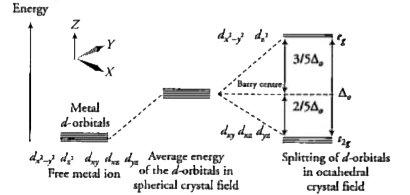Write the assumptions of crystal field theory. Discuss the pattern of splitting of d-orbitals under the effect of an octahedral crystal field.
The main assumptions of crystal field theory are as follows:
(i) The transition metal ion is surrounded by the ligands with lone pairs of electrons and the complex is a combination of central ion surrounded by other ions or molecules or dipoles, e.g. ligands. (ii) All types of ligands are regarded as point charges in case of anions and as dipoles in case of neutral molecules. (iii) The interactions between the metal ion and the negative ends of anion (or ion dipoles) is purely electrostatic, i.e. the bond between the metal and ligand is considered to be 100% ionic. (iv) The ligands surrounding the metal ion produces electrical field and this electrical field influences the energies of the orbitals of central metal ion particularly d-orbitals. (v) In the case of free metal ion, all five d-orbitals have the same energy. Orbitals having the same energies are called degenerate orbitals. The five degenerate d-orbitals of the metal ion split into different sets of orbital having different energies in the presence of electrical field of ligands. This is called crystal field splitting. (vii) The number of ligands and their arrangement (geometry) around the central metal ion will have different effect on the relative energies of the five d-orbitals.
Splitting of d-orbitals under the effect of an octahedral crystal field

The degeneracy of the d-orbitals has been removed due to ligand-metal electron repulsions in the octahedral complex to yield three orbitals of lower energy, t2g , set and two orbitals of higher energy, 2g set. This splitting of the degenerate levels due to the presence of electric field of ligands in a definite geometry is termed as crystal field splitting.
Similar Questions
What are the assumptions of Crystal Field theory.
View SolutionDraw figure to show the splitting of d orbitals in an octahedral crystal field.
View SolutionWhat is crystal field splitting?
View SolutionDraw a sketch to show the splitting of d-orbitals in an octahedral crystal field. State for a d6 configuration, how the actual configuration of the split d-orbitals in an octahedral crystal field is decided by the relative values of Δ0 and P ?
View SolutionWhat is meant by crystal field splitting energy ? On the basis of crystal field theory, write the electronic configuration of d4 in terms of t2g and eg in an octahedral field when
Δ0>P
View SolutionWhat is meant by crystal field splitting energy ? On the basis of crystal field theory, write the electronic configuration of d4 in terms of t2g and eg in an octahedral field when
Δ0<P
View SolutionWhat is meant by crystal field splitting energy? On the basis of crystal field theory, write the electronic configuration of d4 in terms of t2gandeg in an octahedral field when
(i)Δ0>P
(ii) Δ0<P
View SolutionDefine crystal field splitting energy.
View SolutionGive the electronic configuration of the d-orbitals of Ti in [Ti(H2O)6]3+ ion in an octahedral crystal field.
View SolutionDefine crystal field splitting energy ?
View Solution

